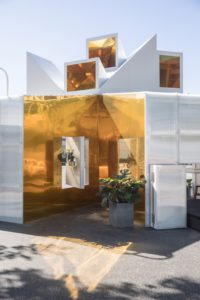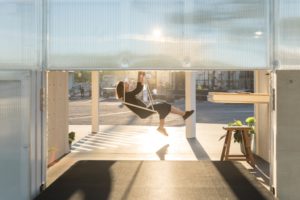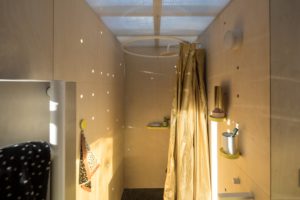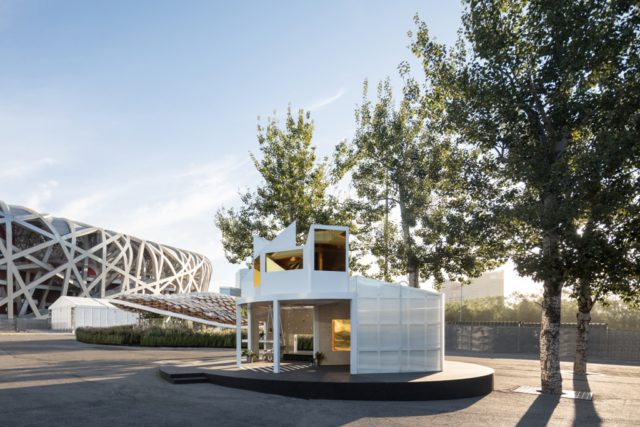MINI presents the latest MINI LIVING Urban Cabin at the interdisciplinary architecture exhibition China House Vision in Beijing from 21 September to 4 November 2018. The micro-apartment concept was developed in cooperation with local architect Dayong Sun.
The Urban Cabin in Beijing is now the fourth interpretation of the concept developed by MINI LIVING last year. The Urban Cabin provides temporary living space with a high degree of flexibility and lots of possibilities. And that is on a surface area of just 15 m2.

One particular design focus is the local identity and culture of the specific location in each case
After stops in London, New York City and Los Angeles, the latest source of inspiration is Beijing.
The central theme of the project is to explore how space can be used in an innovative way. The idea is to create a new sense of community as well as the maximum quality of living on a minimum surface area. In order to achieve this, the MINI LIVING Urban Cabin Beijing re-interprets traditional forms of urban living in China. Thereby the project is stimulating dialogue with community life in the city.
MINI Living started in 2016 and is a project for developing novel residential concepts for urban conurbations worldwide. The designers take into account developments in big cities such as space shortage and price increases as well as the desire for flexibility, local identity and communal interaction. In order to address these diverse aspects, the project takes the “creative use of space” principle as developed for the classic Mini in the field of automotive design and applies it to the residential context.

MINI Living Urban Cabin Beijing: visionary format with historical roots
Every MINI Living Urban Cabin consists of three formal elements. The MINI Living Design Team designed the living and sleeping sections on one side of the micro-apartment and the kitchen and bathroom on the other side. MINI defines the third section as an experiential space with the character of an installation. For each cabin, a local architects’ bureau had an invitation to fill out this space. The theme always has to be relevant to the specific location.
Local architect Dayong Sun collaborated in developing this experiential space in Beijing. He has created an open area of encounter as a homage to the courtyards of the traditional hutongs. Golden, telescope-like mirrors hang above this interactive space, reflecting the immediate environment but also the broader urban context. A swing at the centre of the space provides a playful shift in the viewer’s perspective. The storage and seating facilities around the Urban Cabin are in geometrical shapes. They are a reminder of traditional Chinese tangram puzzles acting as well as as an attractive feature for contemplation.
The hutongs, which are common in Beijing’s more traditional districts, were the inspiration for Dayong Sun’s design. A hallmark feature of the city’s architectural history, these residences consist of courtyard buildings and passageways. People particularly appreciate them for the combination of private withdrawal spaces and communal living areas which they offer. This model is now gradually disappearing from the urban landscape as a result of demographic change. The MINI LIVING Urban Cabin in Beijing echoes the underlying principle of hutong while at the same time translating it to the modern age.

Global network of creative residential solutions
The focus of MINI Living is on forward-looking stimuli for a style of residential architecture that focuses on human beings and their need for individuality, flexibility and community. “Each MINI Living Urban Cabin creates a maximum quality of living within a very limited space in a specific situational context”, explains Oke Hauser, Creative Lead MINI Living. “The result is a global network of creative residential solutions in which people all over the world feel at home, while at the same time providing a public space for innovative forms of co-living.”
The various interpretations of the MINI Living Urban Cabin demonstrate the micro-apartments’ creative possibilities. This has made them the forerunner to the first co-living project in China, which will open in Shanghai in 2019. Here MINI is collaborating with Chinese project developer NOVA Property Investment Co. It converts an unused industrial complex in the Jing’An district into a multi-dimensional facility. The place consists of apartments and workspaces as well as cultural and leisure facilities.
In addition to the creative use of space, the concept offers residents maximum flexibility with residential units of varying sizes and a vibrant urban neighbourhood. An extensive range of digitally bookable services supplements this creative combination of personal privacy and opportunities for communal interaction. This way MINI establishes a whole new level of living quality in the urban setting of a modern city.

































